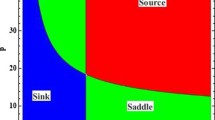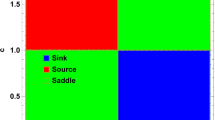Numerous empirical studies over the past two decades have documented substantial effects of plant toxins on diet choice and feeding behavior of herbivores, but analytical models have failed thus far to incorporate toxin-mediated effects of browsing on plant population dynamics. We study a mathematical model that incorporates plant toxicity in the functional response of plant–herbivore interactions. The model also includes a Lotka–Volterra type competition between plants. The model exhibits a rich variety of complex dynamics including Hopf bifurcation and period-doubling bifurcations. Differences in dynamical behavior stem from interspecific differences in plant biology and strategies for growth and defense as well as variation in responses of herbivores to toxins. Analyses suggest that for realistic parameter values, herbivores are capable of promoting coexistence of plant species by ameliorating competitive effects and hence enhancing biodiversity.
Similar content being viewed by others
References
Abrams P.A. (1987). The functional response of adaptive consumers of two resources. Theo. Pop. Biol. 32:262–288
Abrams P.A. (1989). Decreasing functional responses as a result of adaptive consumer behavior. Evol. Eco. Res. 3:95–114
Bloom A.J., Chapin F.S. III, Mooney H.A. (1985). Resource limitation in plants–an economic analogy. Ann. Rev. Ecol. Syst. 16:363–392
Boyle R.B., McLean S., Brandon S., and Wiggins N. (2005). Rapid absorption of dietary 1,8-cineol results in critical blood concentration of cineole and immediate cessation of eating in the common brushtail possum (Trichosurus vulpecula). J. Chem. Ecol. 31:2775–2790
Bryant J.P., and Kuropat P. (1980). Subarctic browsing vertebrate winter forage selection: the role of plant chemistry. Ann. Rev. Ecol. Syst. 11:261–285
Bryant J.P., Chapin F.S. III, Klein D.R. (1983). Carbon/nutrient balance of boreal plants in relation to herbivory. Oikos 40: 357–368
Bryant J.P., Kuropat P.J., Reichardt P.B., Clausen T.P. (1991a). Controls Over the allocation of resources by woody plants to antiherbivore defense. In: Palo R.T., Robbins C.T. (eds) Plant Chemical Defenses Against Mammalian Herbivory. CRC Press, Boca Raton, FL, pp. 83–102
Bryant J.P., Provenza F.D., Pastor J., Reichardt P.B., Clausen T.P., and du Toit J.T. (1991b). Interactions between woody plants and browsing mammals mediated by secondary metabolites. Ann. Rev. Ecol. Syst. 22:431–446
Bryant J.P., Provenza F., Reichardt P.B., and Clausen T.P. (1992). Mammal-woody plant interactions. In: Rosenthall G.A., and Berenbaum M. (eds) Herbivores: Their Interaction with Plant Secondary Metabolites, Vol 2. Academic Press, New York
Bryant J.P., Reichardt P.B., Clausen T.P. (1991c). Effects of global warming on woody plant secondary metabolism in high latitude ecosystems. In: Chapin F.S. III, Jefferies R., Schaver G., Reynolds J., Svoboda J. (eds). Physiological Ecology of Arctic Plants: Implications for Climate Change. Academic Press Inc., New York, pp 1–1
Chapin F.S. III. (1980). The mineral nutrition of wild plants. Ann. Rev. Ecol. Syst. 11:233–260
Chapin F.S. III, Tryon P.R., Van Cleve K. (1983). Influence of phosphorus on growth and biomass distribution of Alaskan taiga tree seedlings. Can. J. Forest Res. 13:1092–1098
Coley P.D., Bryant J.P., Chapin F.S. III. (1985). Resource availability and plant anti-herbivore defense. Science 22:895–899
Crawley M.J. (1992). Natural Enemies: The Population Biology of Predators, Parasites, and Disease. Blackwell Scientific Publications, Oxford
Doedel E.J. (1981). Auto: a program for the automatic bifurcation analysis of autonomous systems. Congr. Numer. 30:265–284
Feeny P. The evolution of chemical ecology: Contributions from the study of herbivorous insects. In: Rosenthal G.A., Berenbaum M. (eds) Herbivores: Their Interactions with Secondary Plant Metabolites, 2nd edn., Vol 2: Evolutionary and Ecological Processes. Academic Press, San Diego Calif., pp. 1–44
Foley W.J., Iason G.R., McArthur C. (1999). Role of plant secondary metabolites in the nutritional ecology of mammalian herbivores: how far have we come in 25 years?. In: Jung H.J.G., Fahey G.C. (eds) Nutritional Ecology of Herbivores. American Society of Animal Science, Savoy, IL, pp. 130–209
Freeland W.J., and Janzen D.H. (1974). Strategies in herbivory by mammals: the role of plant secondary compounds. Am. Nat. 108:269–289
Holling C.S. (1959a). The components of predation as revealed by a study of small mammal predation on the European pine sawfly. Can. Ent. 91:293–320
Holling C.S. (1959b). Some characteristics of simple types of predation and parasitism. Can. Ent. 91:385–398
Janzen D.H., Rosenthal G.A. (1979). Herbivores: Their Interaction with Plant Secondary Metabolites. Academic Press, New York
Lundberg P. (1988). Functional response of a small mammalian herbivore: the disc equation revisited. J. Anim. Ecol. 57:999–1006
Lundberg P., Astrom M. (1990). Functional response of optimally foraging herbivores. J. Theor. Biol. 144:367–377
McLean S., and Duncan A.J. (2006). Pharmacological perspectives on the detoxification of plant secondary metabolites: implications for ingestive behavior of herbivores. J. Chem. Ecol. 32:1213–1228
Palo R.T., Robbins C.T. (1991). Plant Chemical Defenses against Mammalian Herbivory. CRC Press, Boca Raton, FL
Robbins C.T., Mole S., Hagerman A.E., and Hanley T.A. (1987). Role of tannins in defending plants against ruminants: reduction in dry matter digestion?. Ecology 68:1606–1615
Rosenthal G.A., Berenbaum M. (1992). Herbivores: Their Interaction with Plant Secondary Metabolites, vol 2. Academic Press, New York
Spalinger D.E., Hanley T.A., and Robbins C.T. (1988). Analysis of the functional response in the sitka black-tailed deer. Ecology 69:1166–1175
Swihart R.K., Bryant J.P., Newton L. (1994). Latitudinal patterns in consumption of woody plants by snowshoe hares in the eastern United States. Oikos 70:427–434
Van Soest, P. (1982). Nutritional Ecology of the Ruminant. Durham and Downey, Inc.
Villalba J.J., Provenza F.D., Bryant J.P. (2002). Consequences of nutrient-toxin interactions for herbivore selectivity: benefits or detriments for plants?. Oikos 97:282–292
Westoby M. (1974). An analysis of diet selection by large generalist herbivores. Am. Nat. 108:290–304
Westoby M. (1978). What are the biological bases of varied diets?. Am. Nat. 112:627–631
Author information
Authors and Affiliations
Corresponding author
Rights and permissions
About this article
Cite this article
Li, Y., Feng, Z., Swihart, R. et al. Modeling the Impact of Plant Toxicity on Plant–Herbivore Dynamics. J Dyn Diff Equat 18, 1021–1042 (2006). https://doi.org/10.1007/s10884-006-9029-y
Received:
Published:
Issue Date:
DOI: https://doi.org/10.1007/s10884-006-9029-y




